Preparation and Performance of Radiata-Pine-Derived Polyvinyl Alcohol/Carbon Quantum Dots Fluorescent Films
Abstract
:1. Introduction
2. Materials and Methods
2.1. Materials
2.2. Synthesis of CQDs from Radiata Pine Processing Waste
2.3. Fabrication of PVA-Based Films
2.3.1. Experimental Method
2.3.2. Fabrication of PVA-Based Films
2.3.3. Characterizations of the Obtained CQDs
2.3.4. Characterizations of PVA-Based Films
3. Results and Discussion
3.1. Optical Performance of the Prepared CQDs
3.2. PL Property of the Prepared PVA-Based Films
3.3. Optical Performance of the Prepared PVA-Based Films
3.3.1. PL Spectra of the Prepared PVA-Based Films
3.3.2. FTIR Spectra of the PVA-Based Films
3.4. Barrier Property to Light of the Prepared PVA-Based Films
3.5. Tensile Properties of the Prepared PVA-Based Films
3.6. Water-Resistance of the Prepared PVA-Based Films
3.7. Surface Wettability of PVA-Based Films
4. Conclusions
Author Contributions
Funding
Acknowledgments
Conflicts of Interest
References
- Zhu, Y.K.; Chen, D.J. Clay-based nanofibrous membranes reinforced by multi-walled carbon nanotubes. Ceram. Int. 2018, 44, 15873–15879. [Google Scholar] [CrossRef]
- Wu, M.C.; Chan, S.H.; Lin, T.H. Fabrication and photocatalytic performance of electrospun PVA/silk/TiO2 nanocomposite textile. Funct. Mater. Lett. 2015, 8, 1540013. [Google Scholar] [CrossRef]
- Hassannejad, H.; Nouri, A.; Soltani, S.; Molavi, F.K. Study of corrosion behavior of the biodegradable chitosan-polyvinyl alcohol coatings on AA8011 aluminum alloy. Mater. Res. Express 2019, 6, 055312. [Google Scholar] [CrossRef]
- Zhu, C.; Xiang, Q.; Liu, X.Y.; Dong, L.M. Study on antiseptic property of water soluble polyvinyl alcohol building adhesive. In Proceedings of the 2016 International Conference on Advances in Energy, Environment and Chemical Science (AEECS 2016), Changsha, China, 23–24 April 2016; Volume 76, pp. 4–8. [Google Scholar]
- Abdullah, Z.W.; Dong, Y.; Davies, I.J.; Barbhuiya, S. PVA, PVA blends, and their nanocomposites for biodegradable packaging application. Polym. Plast. Technol. 2017, 56, 1307–1344. [Google Scholar] [CrossRef] [Green Version]
- Gaaz, T.S.; Sulong, A.B.; Akhtar, M.N.; Kadhum, A.A.H.; Mohamad, A.B.; Al-Amiery, A.A. Properties and applications of polyvinyl Alcohol, halloysite nanotubes and their nanocomposites. Molecules 2015, 20, 22833–22847. [Google Scholar] [CrossRef] [PubMed] [Green Version]
- Arain, M.F.; Wang, M.X.; Chen, J.Y.; Zhang, H.P. Study on PVA fiber surface modification for strain-hardening cementitious composites (PVA-SHCC). Constr. Build. Mater. 2019, 197, 107–116. [Google Scholar] [CrossRef]
- Lelifajri; Nawi, M.A.; Sabar, S.; Supriatno; Nawawi, W.I. Preparation of immobilized activated carbon-polyvinyl alcohol composite for the adsorptive removal of 2,4-dichlorophenoxyacetic acid. J. Water Process Eng. 2018, 25, 269–277. [Google Scholar] [CrossRef]
- Baker, M.I.; Walsh, S.P.; Schwartz, Z.; Boyan, B.D. A review of polyvinyl alcohol and its uses in cartilage and orthopedic applications. J. Biomed. Mater. Res. Part B 2012, 100, 1451–1457. [Google Scholar] [CrossRef]
- Kim, S.J.; Park, S.J.; Kim, S.I. Swelling behavior of interpenetrating polymer network hydrogels composed of poly (vinyl alcohol) and chitosan. React. Funct. Polym. 2003, 55, 53–59. [Google Scholar] [CrossRef]
- Heuschmid, F.F.; Schneider, S.; Schuster, P.; Lauer, B.; van Ravenzwaay, B. Polyethylene glycol-g-polyvinyl alcohol grafted copolymer: Reproductive toxicity study in wistar rats. Food. Chem. Toxicol. 2013, 51 (Suppl. 1), S24–S35. [Google Scholar] [CrossRef]
- Limpan, N.; Prodpran, T.; Benjakul, S.; Prasarpran, S. Influences of degree of hydrolysis and molecular weight of poly(vinyl alcohol) (PVA) on properties of fish myofibrillar protein/PVA blend films. Food Hydrocoll. 2012, 29, 226–233. [Google Scholar] [CrossRef]
- Chen, C.W.; Xie, J.; Yang, F.X.; Zhang, H.L.; Xu, Z.W.; Liu, J.L.; Chen, Y.J. Development of moisture-absorbing and antioxidant active packaging film based on poly (vinyl alcohol) incorporated with green tea extract and its effect on the quality of dried eel. J. Food Process. Preserv. 2018, 42, e13374. [Google Scholar] [CrossRef] [Green Version]
- Hong, H.Q.; Liao, H.Y.; Chen, S.J.; Zhang, H.Y. Facile method to prepare self-healable PVA hydrogels with high water stability. Mater. Lett. 2014, 122, 227–229. [Google Scholar] [CrossRef]
- Toyoda, N.; Yamamoto, T. Dispersion of carbon nanofibers modified with polymer colloids to enhance mechanical properties of PVA nanocomposite film. Colloid Surf. A 2018, 556, 248–252. [Google Scholar] [CrossRef]
- Yu, Z.; Li, B.Q.; Chu, J.Y.; Zhang, P.F. Silica in situ enhanced PVA/chitosan biodegradable films for food packages. Carbohydr. Polym. 2018, 184, 214–220. [Google Scholar] [CrossRef]
- Lan, W.J.; Zhang, R.; Ahmed, S.; Qin, W.; Liu, Y.W. Effects of various antimicrobial polyvinyl alcohol/tea polyphenol composite films on the shelf life of packaged strawberries. LWT Food. Sci. Technol. 2019, 113, 108297. [Google Scholar] [CrossRef]
- Rowe, A.A.; Tajvidi, M.; Gardner, D.J. Thermal stability of cellulose nanomaterials and their composites with polyvinyl alcohol (PVA). J. Therm. Anal. Calorim. 2016, 126, 1371–1386. [Google Scholar] [CrossRef]
- Han, J.Q.; Yue, Y.Y.; Wu, Q.L.; Huang, C.B.; Pan, H.; Zhan, X.X.; Mei, C.T.; Xu, X.W. Effects of nanocellulose on the structure and properties of poly (vinyl alcohol)-borax hybrid foams. Cellulose 2017, 24, 4433–4448. [Google Scholar] [CrossRef]
- Dufresne, A. Nanocellulose: A new ageless bionanomaterial. Mater. Today 2013, 16, 220–227. [Google Scholar] [CrossRef]
- Klemm, D.; Kramer, F.; Moritz, S.; Lindstrom, T.; Ankerfors, M.; Gray, D.; Dorris, A. Nanocelluloses: A new family of nature-based materials. Angew. Chem. Int. Ed. 2011, 50, 5438–5466. [Google Scholar] [CrossRef]
- Wang, H.Y.; Chen, C.C.; Fang, L.; Li, S.Y.; Chen, N.; Pang, J.W.; Li, D.G. Effect of delignification technique on the ease of fibrillation of cellulose II nanofibers from wood. Cellulose 2018, 25, 7003–7015. [Google Scholar] [CrossRef]
- Phanthong, P.; Reubroycharoen, P.; Hao, X.G.; Xu, G.W.; Abudula, A.; Guan, G.Q. Nanocellulose: Extraction and application. Carbon Resour. Convers. 2018, 1, 32–43. [Google Scholar] [CrossRef]
- Wang, H.Y.; Wu, T.T.; Wang, X.X.; Cheng, X.D.; Chen, N.; Li, D.G. Effect of ethylenediamine treatment on cellulose nanofibers and the formation of high-strength hydrogels. Bioresources 2019, 14, 1141–1156. [Google Scholar]
- Chen, C.C.; Li, D.G.; Abe, K.; Yano, H. Formation of high strength double-network gels from cellulose nanofiber/polyacrylamide via NaOH gelation treatment. Cellulose 2018, 25, 5089–5097. [Google Scholar] [CrossRef]
- Ching, Y.C.; Rahman, A.; Ching, K.Y.; Sukiman, N.L.; Cheng, H.C. Preparation and characterization of polyvinyl alcohol-based composite reinforced with nanocellulose and nanosilica. Bioresources 2015, 10, 3364–3377. [Google Scholar] [CrossRef]
- Hietala, M.; Sain, S.; Oksman, K. Highly redispersible sugar beet nanofibrils as reinforcement in bionanocomposites. Cellulose 2017, 24, 2177–2189. [Google Scholar] [CrossRef]
- Acharya, A. Luminescent magnetic quantum dots for in vitro/in vivo imaging and applications in therapeutics. J. Nanosci. Nanotechnol. 2013, 13, 3753–3768. [Google Scholar] [CrossRef]
- Shi, Y.X.; Liu, X.; Wang, M.; Huang, J.B.; Jiang, X.Q.; Pang, J.H.; Xu, F.; Zhang, X.M. Synthesis of N-doped carbon quantum dots from bio-waste lignin for selective irons detection and cellular imaging. Int. J. Biol. Macromol. 2019, 128, 537–545. [Google Scholar] [CrossRef]
- Lei, C.W.; Hsieh, M.L.; Liu, W.R. A facile approach to synthesize carbon quantum dots with pH-dependent properties. Dyes Pigments 2019, 169, 73–80. [Google Scholar] [CrossRef]
- Zhao, J.X.; Liu, C.; Li, Y.C.; Liang, J.Y.; Liu, J.Y.; Qian, T.H.; Ding, J.J.; Cao, Y.C. Preparation of carbon quantum dots based high photostability luminescent membranes. Luminescence 2017, 32, 625–630. [Google Scholar] [CrossRef]
- Zhang, L.G.; Wang, Y.; Liu, W.; Ni, Y.H.; Hou, Q.X. Corncob residues as carbon quantum dots sources and their application in detection of metal ions. Ind. Crops Prod. 2019, 133, 18–25. [Google Scholar] [CrossRef]
- Yan, J.Y.; Hou, S.L.; Yu, Y.Z.; Qiao, Y.; Xiao, T.Q.; Mei, Y.; Zhang, Z.J.; Wang, B.; Huang, C.C.; Liu, C.H.; et al. The effect of surface charge on the cytotoxicity and uptake of carbon quantum dots in human umbilical cord derived mesenchymal stem cells. Colloid Surf. B 2018, 171, 241–249. [Google Scholar] [CrossRef] [PubMed]
- Atchudan, R.; Edison, T.N.J.I.; Aseer, K.R.; Perumal, S.; Karthik, N.; Lee, Y.R. Highly fluorescent nitrogen-doped carbon dots derived from Phyllanthus acidus utilized as a fluorescent probe for label-free selective detection of Fe3+ ions, live cell imaging and fluorescent ink. Biosens. Bioelectron. 2018, 99, 303–311. [Google Scholar] [CrossRef] [PubMed]
- Chandra, S.; Singh, V.K.; Yadav, P.K.; Bano, D.; Kumar, V.; Pandey, V.K.; Talat, M.; Hasan, S.H. Mustard seeds derived fluorescent carbon quantum dots and their peroxidase-like activity for colorimetric detection of H2O2 and ascorbic acid in a real sample. Anal. Chim. Acta 2018, 1054, 145–156. [Google Scholar] [CrossRef] [PubMed]
- Arul, V.; Sethuraman, M.G. Facile green synthesis of fluorescent N-doped carbon dots from Actinidia deliciosa and their catalytic activity and cytotoxicity applications. Opt. Mater. 2018, 78, 181–190. [Google Scholar] [CrossRef]
- Atchudan, R.; Edison, T.N.J.I.; Lee, Y.R. Nitrogen-doped carbon dots originating from unripe peach for fluorescent bioimaging and electrocatalytic oxygen reduction reaction. J. Colloid Interface Sci. 2016, 482, 8–18. [Google Scholar] [CrossRef] [PubMed]
- Wang, X.; Yang, P.; Feng, Q.; Meng, T.T.; Wei, J.; Xu, C.Y.; Han, J.Q. Green Preparation of Fluorescent Carbon Quantum Dots from Cyanobacteria for Biological Imaging. Polymers 2019, 11, 616. [Google Scholar] [CrossRef] [Green Version]
- Dong, L.; Xiong, Z.R.; Liu, X.D.; Sheng, D.K.; Zhou, Y.; Yang, Y.M. Synthesis of carbon quantum dots to fabricate ultraviolet-shielding poly(vinylidene fluoride) films. J. Appl. Polym. Sci. 2019, 136, 47555. [Google Scholar] [CrossRef]
- El-Shamy, A.G. New free-standing and flexible PVA/Carbon quantum dots (CQDs) nanocomposite films with promising power factor and thermoelectric power applications. Mater. Sci. Semicond. Proc. 2019, 100, 245–254. [Google Scholar] [CrossRef]
- Vandarkuzhali, S.A.A.; Jeyalakshmi, V.; Sivaraman, G.; Singaravadivel, S.; Krishnamurthy, K.R.; Viswanathan, B. Highly fluorescent carbon dots from Pseudo-stem of banana plant: Applications as nanosensor and bio-imaging agents. Sens. Actuator B Chem. 2017, 252, 894–900. [Google Scholar] [CrossRef]
- Bao, R.Q.; Chen, Z.Y.; Zhao, Z.W.; Sun, X.; Zhang, J.Y.; Hou, L.R.; Yuan, C.Z. Green and facile synthesis of nitrogen and phosphorus co-doped carbon quantum dots towards fluorescent ink and sensing applications. J. Nanomater. 2018, 8, 386. [Google Scholar] [CrossRef] [PubMed] [Green Version]
- Xue, B.L.; Yang, Y.; Sun, Y.C.; Fan, J.S.; Li, X.P.; Zhang, Z. Photoluminescent lignin hybridized carbon quantum dots composites for bioimaging applications. Int. J. Biol. Macromol. 2019, 122, 954–961. [Google Scholar] [CrossRef] [PubMed]
- Temerov, F.; Belyaev, A.; Ankudze, B.; Pakkanen, T.T. Preparation and photoluminescence properties of graphene quantum dots by decomposition of graphene-encapsulated metal nanoparticles derived from Kraft lignin and transition metal salts. J. Lumin. 2019, 206, 403–411. [Google Scholar] [CrossRef]
- Zhou, L.F.; Qiao, M.; Zhang, L.; Sun, L.; Zhang, Y.; Liu, W.W. Green and efficient synthesis of carbon quantum dots and their luminescent properties. J. Lumin. 2019, 206, 158–163. [Google Scholar] [CrossRef]
- Eda, G.; Lin, Y.Y.; Mattevi, C.; Yamaguchi, H.; Chen, H.A.; Chen, I.S.; Chen, C.W.; Chhowalla, M. Blue photoluminescence from chemically derived graphene oxide. Adv. Mater. 2010, 22, 505–509. [Google Scholar] [CrossRef] [PubMed]
- Sun, Y.P.; Zhou, B.; Lin, Y.; Wang, W.; Fernando, K.A.S.; Pathak, P.; Meziani, M.J.; Harruff, B.A.; Wang, X.; Wang, H.F.; et al. Quantum-sized carbon dots for bright and colorful photoluminescence. J. Am. Chem. Soc. 2006, 128, 7756–7757. [Google Scholar] [CrossRef]
- Pan, D.Y.; Zhang, J.C.; Li, Z.; Wu, M.H. Hydrothermal route for cutting graphene sheets into blue-luminescent graphene quantum dots. Adv. Mater. 2010, 22, 734–738. [Google Scholar] [CrossRef]
- Wang, C.J.; Wang, Y.B.; Shi, H.X.; Yan, Y.J.; Liu, E.Z.; Hu, X.Y.; Fan, J. A strong blue fluorescent nanoprobe for highly sensitive and selective detection of mercury (II) based on sulfur doped carbon quantum dots. Mater. Chem. Phys. 2019, 232, 145–151. [Google Scholar] [CrossRef]
- Hoang, Q.B.; Mai, V.T.; Nguyen, D.K.; Truong, D.Q.; Mai, X.D. Crosslinking induced photoluminescence quenching in polyvinyl alcohol-carbon quantum dot composite. Mater. Today Chem. 2019, 12, 166–172. [Google Scholar] [CrossRef]
- Dulkeith, E.; Morteani, A.C.; Niedereichholz, T.; Klar, T.A.; Feldmann, J.; Levi, S.A.; van Veggel, F.C.J.M.; Reinhoudt, D.N.; Moller, M.; Gittins, D.I. Fluorescence quenching of dye molecules near gold nanoparticles: Radiative and nonradiative effects. Phys. Rev. Lett. 2002, 89, 203002. [Google Scholar] [CrossRef] [Green Version]
- Liu, T.; Li, N.; Dong, J.X.; Luo, H.Q.; Li, N.B. Fluorescence detection of mercury ions and cysteine based on magnesium and nitrogen co-doped carbon quantum dots and IMPLICATION logic gate operation. Sens. Actuators B Chem. 2016, 231, 147–153. [Google Scholar] [CrossRef]
- Zhao, Q.L.; Zhang, Z.L.; Huang, B.H.; Peng, J.; Zhang, M.; Pang, D.W. Facile preparation of low cytotoxicity fluorescent carbon nanocrystals by electrooxidation of graphite. Chem. Commun. 2008, 41, 5116–5118. [Google Scholar] [CrossRef] [PubMed]
- Htun, M.T. Characterization of high-density polyethylene using laser-induced fluorescence (LIF). J. Polym. Res. 2012, 19, 9823. [Google Scholar] [CrossRef]
- Yang, L.; Huang, B.Q.; Wei, X.F.; Zhang, W.; Wang, D.D. The Research on Fluorescence Intensity Attenuation of UV Fluorescent Inkjet Ink. In Proceedings of the 29th International Conference on Digital Printing Technologies (NIP29)/Digital Fabrication 2013, Seattle, WA, USA, 29 September–3 October 2013. [Google Scholar]
- Wang, Q.Q.; Zhu, J.Y.; Gleisner, R.; Kuster, T.A.; Baxa, U.; McNeil, S.E. Morphological development of cellulose fibrils of a bleached eucalyptus pulp by mechanical fibrillation. Cellulose 2014, 19, 1631–1643. [Google Scholar] [CrossRef]
- Jing, X.; Li, H.; Mi, H.Y.; Liu, Y.J.; Feng, P.Y.; Tan, Y.M.; Turng, L.S. Highly transparent, stretchable, and rapid self-healing polyvinyl alcohol/cellulose nanofibril hydrogel sensors for sensitive pressure sensing and human motion detection. Sens. Actuators B Chem. 2019, 252, 159–167. [Google Scholar] [CrossRef]
- Wang, Y.Q.; Xue, Y.A.; Wang, J.H.; Zhu, Y.P.; Wang, X.; Zhang, X.H.; Zhu, Y.; Liao, J.W.; Li, X.N.; Wu, X.G.; et al. Biocompatible and photoluminescent carbon dots/hydroxyapatite/PVA dual-network composite hydrogel scaffold and their properties. J. Polym. Res. 2019, 26, 248. [Google Scholar] [CrossRef]
- Yan, Z.D.; Sun, L.D.; Hu, C.G.; Hu, X.T.; Zeppenfeld, P. Factors influencing the ability of fluorescence emission and fluorescence quenching experimental research. Spectrosc. Spect. Anal. 2012, 32, 2718–2721. [Google Scholar]
- Ma, X.T.; Li, S.R.; Hessel, V.; Lin, L.L.; Meskers, S.; Gallucci, F. Synthesis of luminescent carbon quantum dots by microplasma process. Chem. Eng. Process. Process Intensif. 2019, 140, 29–35. [Google Scholar] [CrossRef]
- Mahmud, H.N.M.E.; Kassim, A.; Zainal, Z.; Yunus, W.M.M. Fourier transform infrared study of polypyrrole-poly (vinyl alcohol) conducting polymer composite films: Evidence of film formation and characterization. J. Appl. Polym. Sci. 2006, 100, 4107–4113. [Google Scholar] [CrossRef]
- Saikia, M.; Hower, J.C.; Das, T.; Dutta, T.; Saikia, B.K. Feasibility study of preparation of carbon quantum dots from Pennsylvania anthracite and Kentucky bituminous coals. Fuel 2019, 243, 433–440. [Google Scholar] [CrossRef]
- Li, D.P.; Wu, Z.J.; Hang, C.H.; Chen, L.J.; Zhang, Y.L.; Ne, Y.X. Analysis of the Character of Film Decomposition of Methyl Methacrylate (MMA) Coated Urea by Infrared Spectrum. Spectrosc. Spect. Anal. 2012, 32, 635–641. [Google Scholar]
- Behera, B.; Das, P.K. Blue- and Red-Shifting Hydrogen Bonding: A Gas Phase FTIR and Ab Initio Study of RR’ CO center dot center dot center dot DCCI3 and RR’ S center dot center dot center dot DCCI3 Complexes. J. Phys. Chem. A 2018, 122, 4481–4489. [Google Scholar] [CrossRef] [PubMed]
- El-Shamy, A.G. Novel conducting PVA/Carbon quantum dots (CQDs) nanocomposite for high anti- electromagnetic wave performance. J. Alloy Compd. 2019, 810, 151940. [Google Scholar] [CrossRef]
- Hertmanowski, R.; Biadasz, A.; Martynski, T.; Bauman, D. Optical spectroscopy study of some 3,4,9,10-tetra-(n-alkoxy-carbonyl)-perylenes in Langmuir-Blodgett films. J. Mol. Struct. 2003, 646, 25–33. [Google Scholar] [CrossRef]
- Baraker, B.M.; Lobo, B. Spectroscopic Analysis of CdCl2 doped PVA-PVP Blend Films. Can. J. Phys. 2017, 95, 738–747. [Google Scholar] [CrossRef] [Green Version]
- Lee, J.H.; Ko, K.H.; Park, B.O. Electrical and optical properties of ZnO transparent conducting films by the sol–gel method. J. Cryst. Growth 2003, 247, 119–125. [Google Scholar] [CrossRef]
- Baraker, B.M.; Lobo, B. UV irradiation induced microstructural changes in CdCl2 doped PVA–PVP blend. J. Mater. Sci. Mater. Electron. 2018, 29, 4106–4121. [Google Scholar] [CrossRef]
- Riaz, R.; Ali, M.; Maiyalagan, T.; Anjum, A.S.; Lee, S.; Ko, M.J.; Jeong, S.H. Dye-sensitized solar cell (DSSC) coated with energy down shift layer of nitrogen-doped carbon quantum dots (N-CQDs) for enhanced current density and stability. Appl. Surf. Sci. 2019, 483, 425–431. [Google Scholar] [CrossRef]
- Liu, D.G.; Sun, X.; Tian, H.F.; Maiti, S.; Ma, Z.S. Effects of cellulose nanofibrils on the structure and properties on PVA nanocomposites. Cellulose 2013, 20, 2981–2989. [Google Scholar] [CrossRef]
- Yang, X.M.; Shang, S.M.; Li, L.A. Layer-structured poly (vinyl alcohol)/graphene oxide nanocomposites with improved thermal and mechanical properties. J. Appl. Polym. Sci. 2011, 120, 1355–1360. [Google Scholar] [CrossRef]
- Wu, Y.; Tang, Q.W.; Yang, F.; Xu, L.; Wang, X.H.; Zhang, J.L. Mechanical and thermal properties of rice straw cellulose nanofibrils-enhanced polyvinyl alcohol films using freezing-and-thawing cycle method. Cellulose 2019, 26, 3193–3204. [Google Scholar] [CrossRef]
- Kumar, S.V.; George, J.; Sajeevkumar, V.A. PVA Based Ternary Nanocomposites with Enhanced Properties Prepared by Using a Combination of Rice Starch Nanocrystals and Silver Nanoparticles. J. Polym. Environ. 2018, 26, 3117–3127. [Google Scholar] [CrossRef]
- Sehaqui, H.; Zimmermann, T.; Tingaut, P. Hydrophobic cellulose nanopaper through a mild esterification procedure. Cellulose 2014, 21, 367–382. [Google Scholar] [CrossRef] [Green Version]
- Xu, M.H.; Zhang, W.; Yang, Z.; Yu, F.; Ma, Y.J.; Hu, N.T.; He, D.N.; Liang, Q.; Su, Y.J.; Zhang, Y.F. One-pot liquid-phase exfoliation from graphite to graphene with carbon quantum dots. Nanoscale 2015, 7, 10527–10537. [Google Scholar] [CrossRef]
- Yin, J.; Deng, B.L. Polymer-matrix nanocomposite membranes for water treatment. J. Membr. Sci. 2015, 479, 256–275. [Google Scholar] [CrossRef]
- Oza, G.; Ravichandran, M.; Merupo, V.I.; Shinde, S.; Mewada, A.; Ramirez, J.T.; Velumani, S.; Sharon, M.; Sharon, M. Camphor-mediated synthesis of carbon nanoparticles, graphitic shell encapsulated carbon nanocubes and carbon dots for bioimaging. Sci. Rep. U. K. 2016, 6, 21286. [Google Scholar] [CrossRef]
- Wang, Z.; Zhao, S.J.; Zhang, W.; Qi, C.S.; Zhang, S.F.; Li, J.Z. Bio-inspired cellulose nanofiber-reinforced soy protein resin adhesives with dopamine-induced codeposition of “water-resistant” interphases. Appl. Surf. Sci. 2019, 478, 441–450. [Google Scholar] [CrossRef]
- Shahbazi, M.; Rajabzadeh, G.; Rafe, A.; Ettelaie, R.; Ahmadi, S.J. Physico-mechanical and structural characteristics of blend film of poly (vinyl alcohol) with biodegradable polymers as affected by disorderto-order conformational transition. Food Hydrocoll. 2017, 71, 259–269. [Google Scholar] [CrossRef] [Green Version]
- Gai, W.X.; Zhao, D.L.; Chung, T.S. Thin film nanocomposite hollow fiber membranes comprising Na+-functionalized carbon quantum dots for brackish water desalination. Water Res. 2019, 154, 54–61. [Google Scholar] [CrossRef]
- Tang, C.Y.Y.; Kwon, Y.N.; Leckie, J.O. Effect of membrane chemistry and coating layer on physiochemical properties of thin film composite polyamide RO and NF membranes I. FTIR and XPS characterization of polyamide and coating layer chemistry. Desalination 2009, 242, 149–167. [Google Scholar] [CrossRef]
- Priezjev, N.V.; Darhuber, A.A.; Troian, S.M. Slip behavior in liquid films on surfaces of patterned wettability: Comparison between continuum and molecular dynamics simulations. Funct. Mater. Lett. 2005, 8, 1–11. [Google Scholar] [CrossRef] [PubMed] [Green Version]
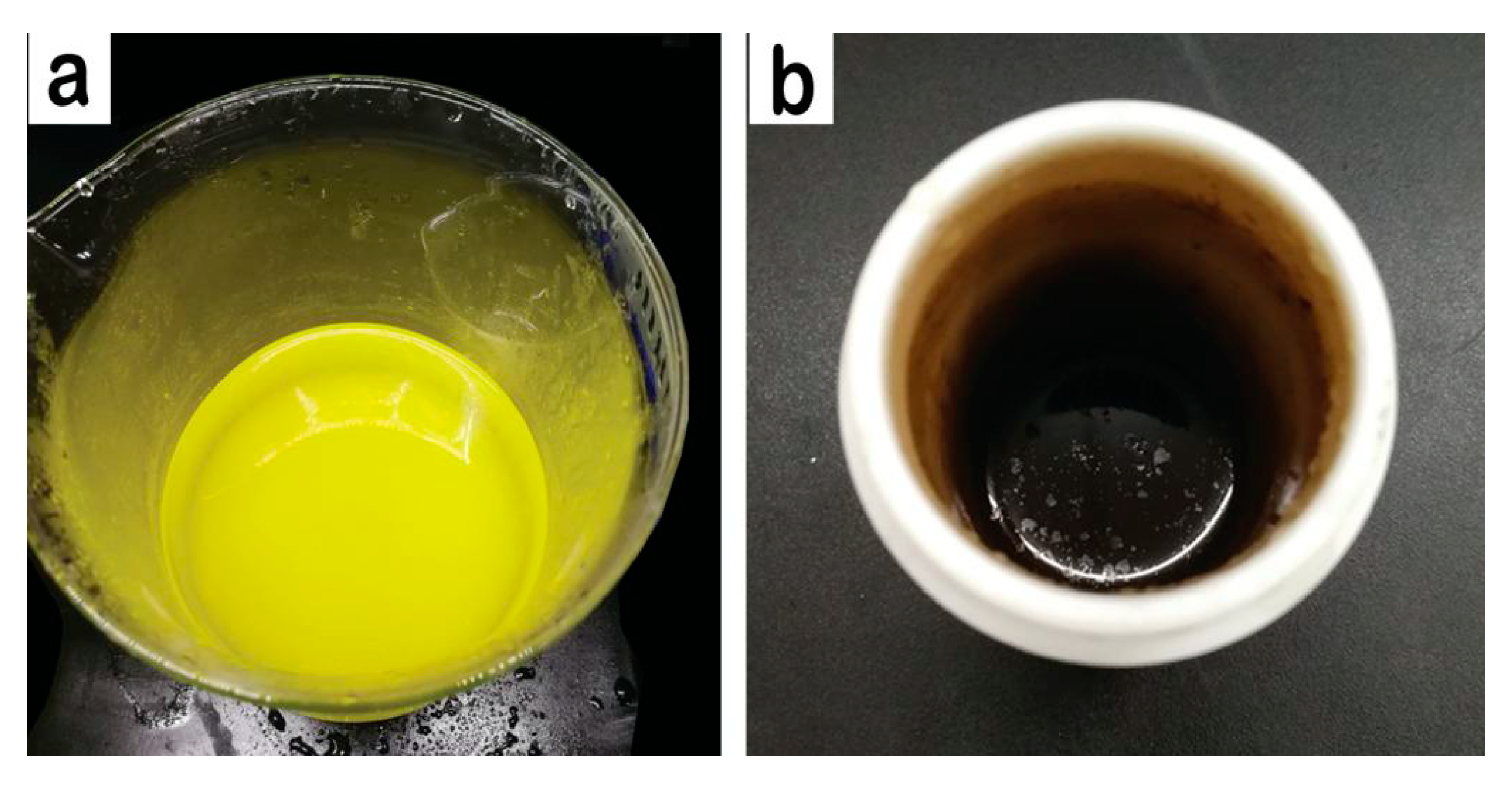
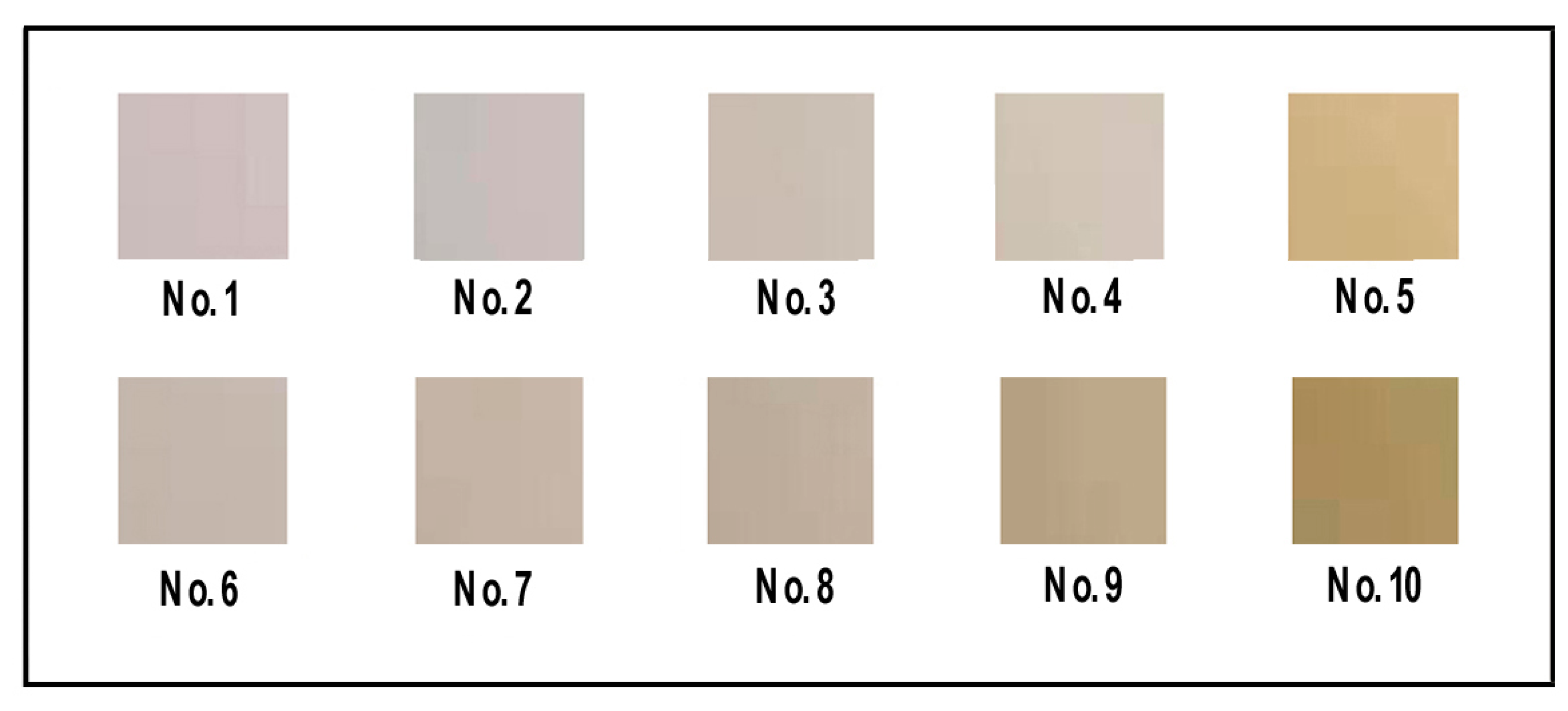
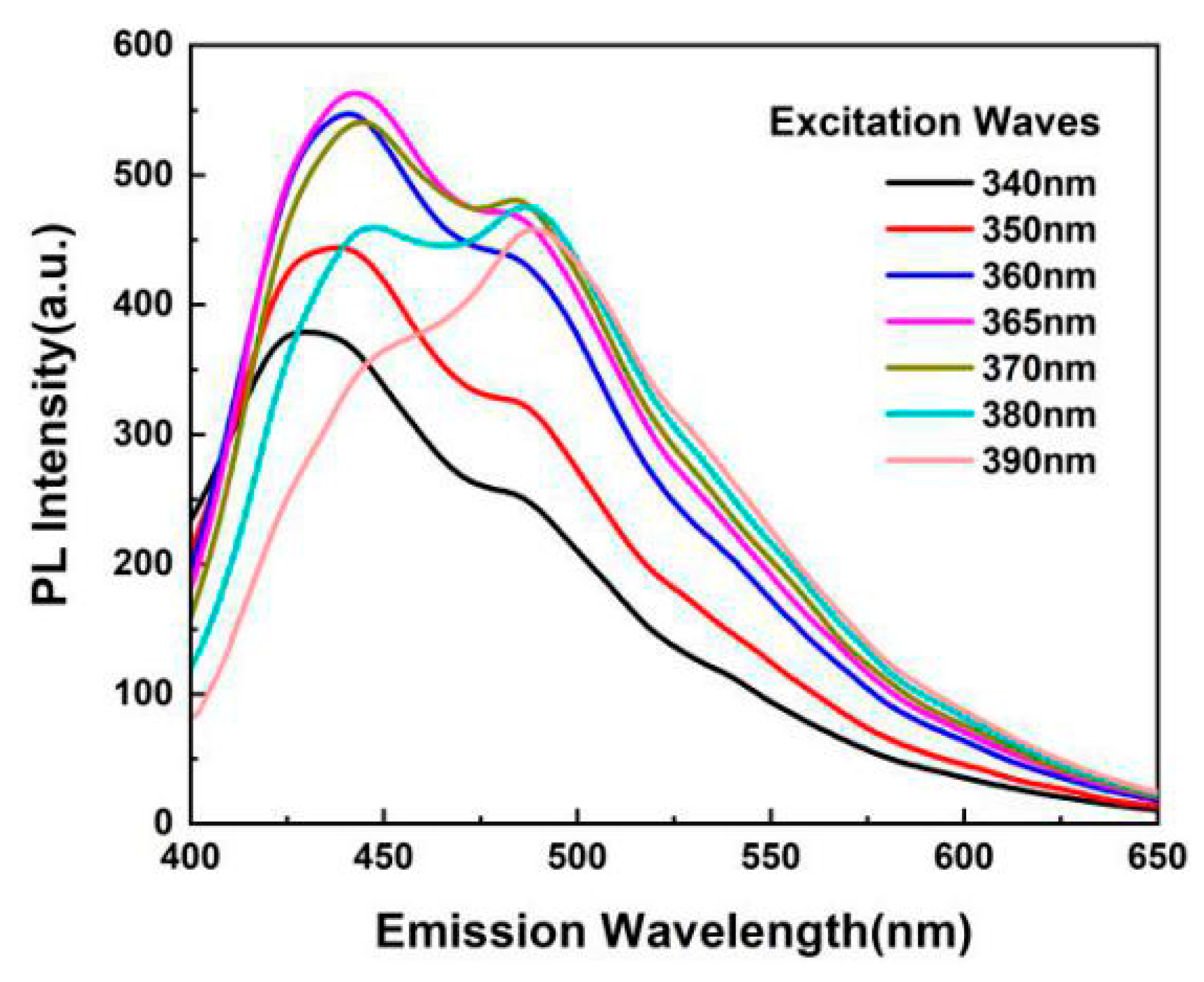
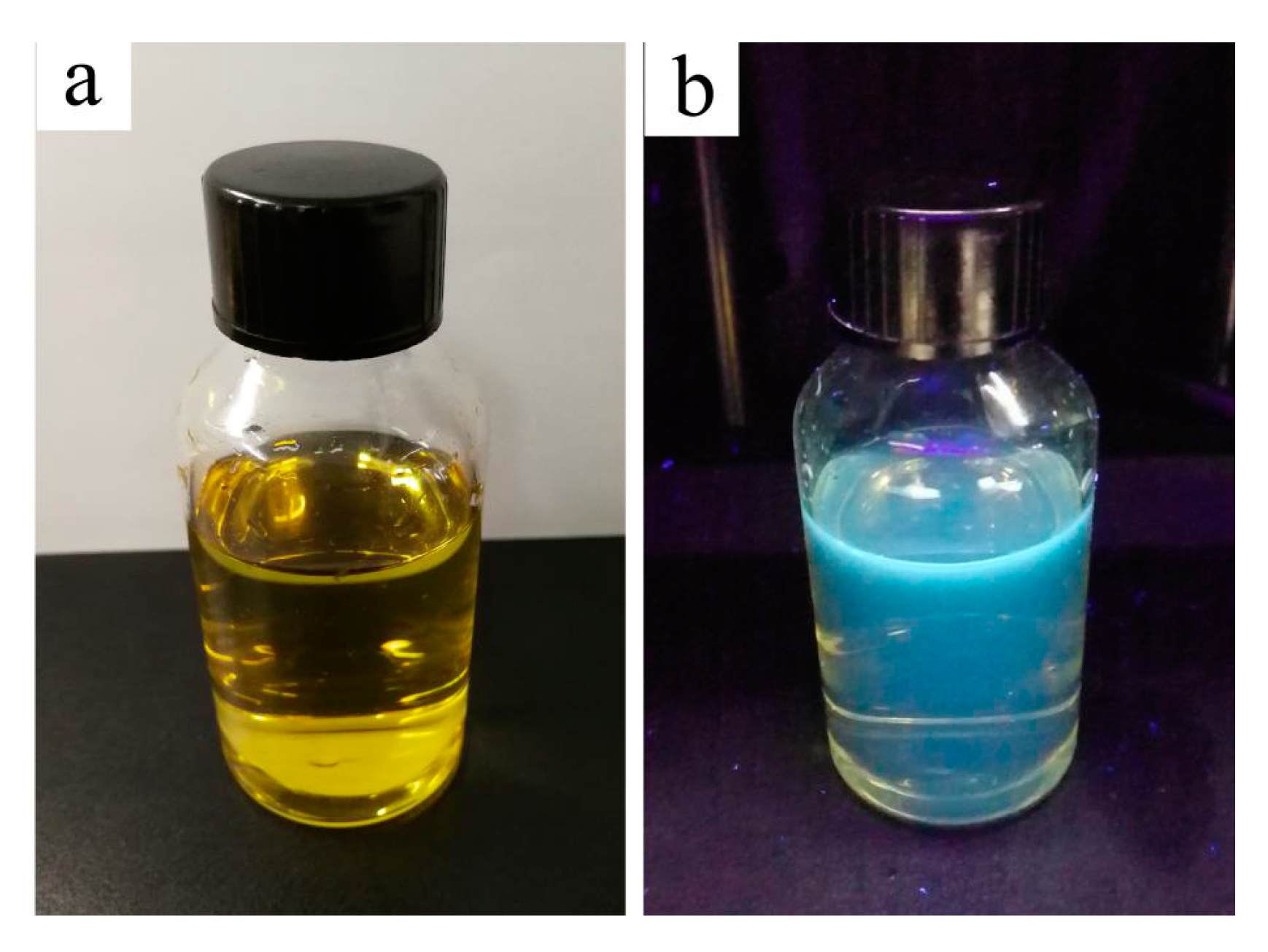
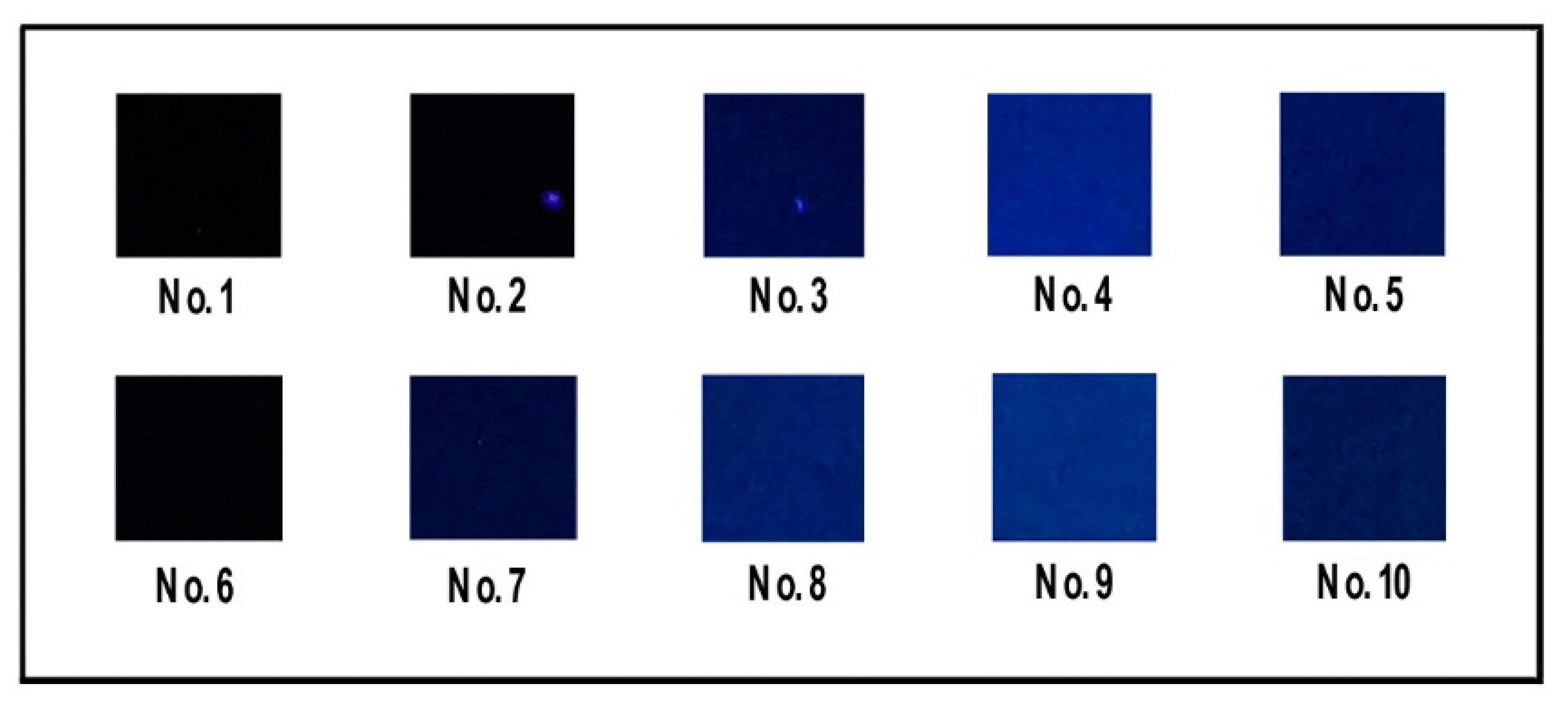
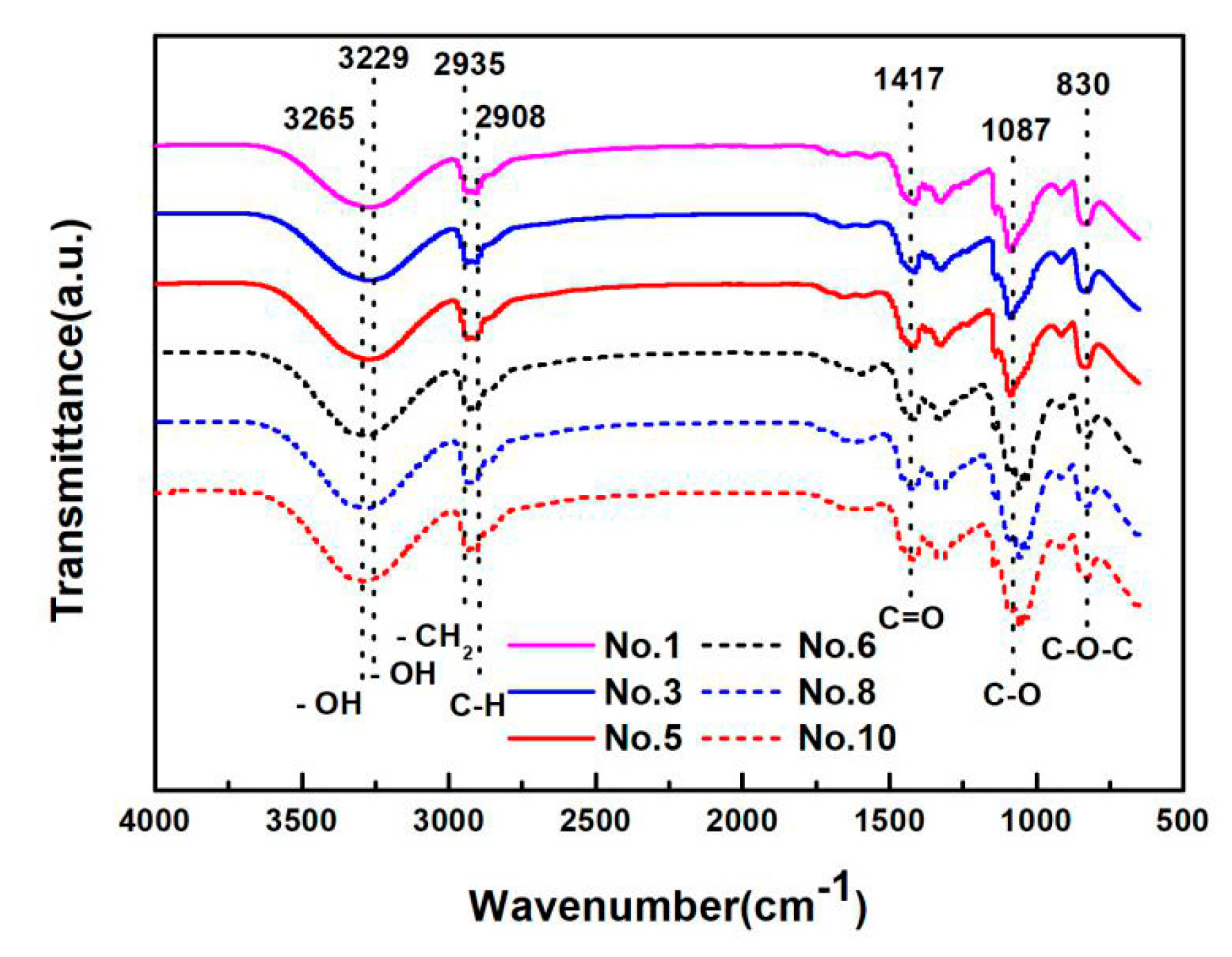
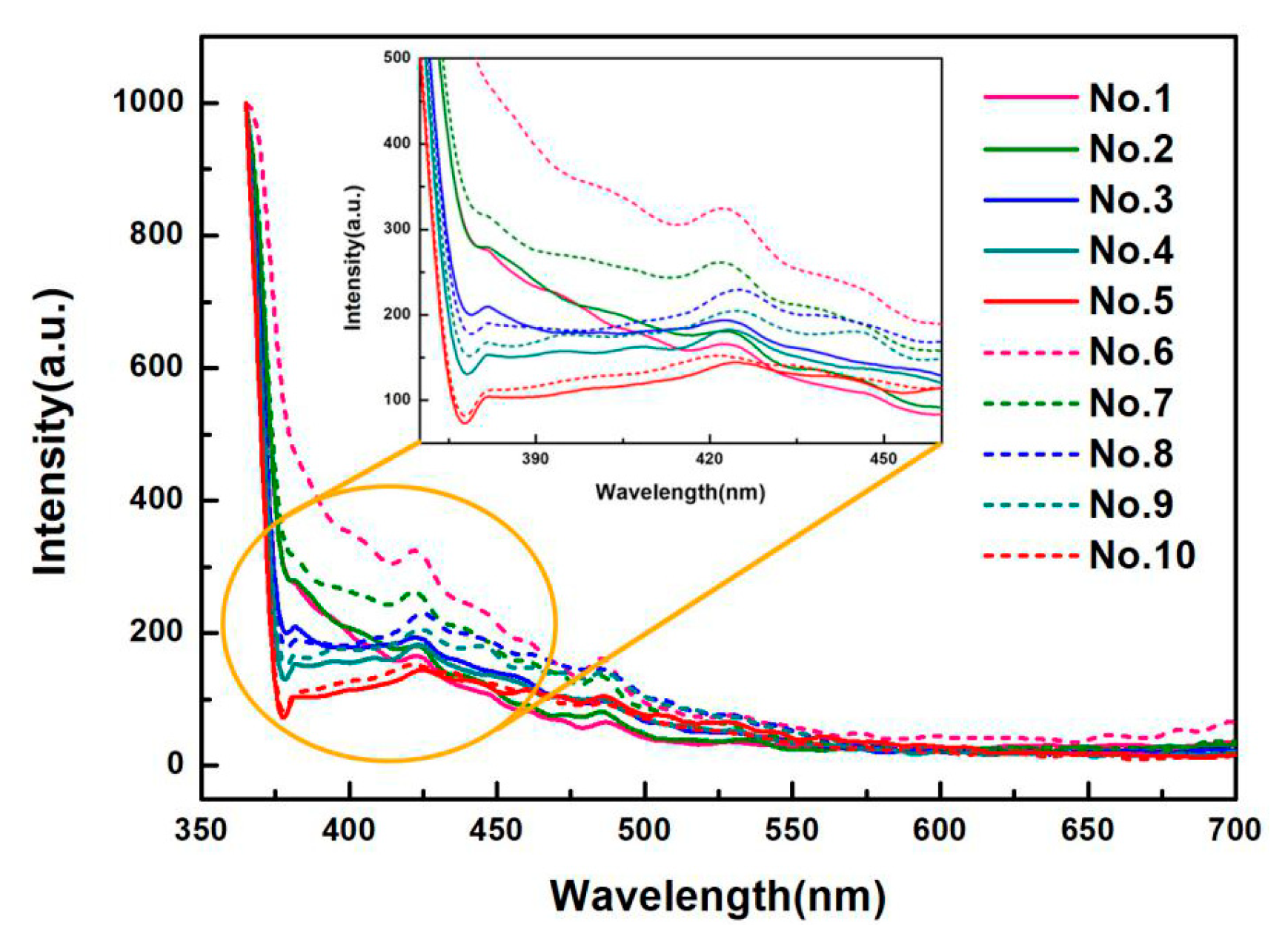
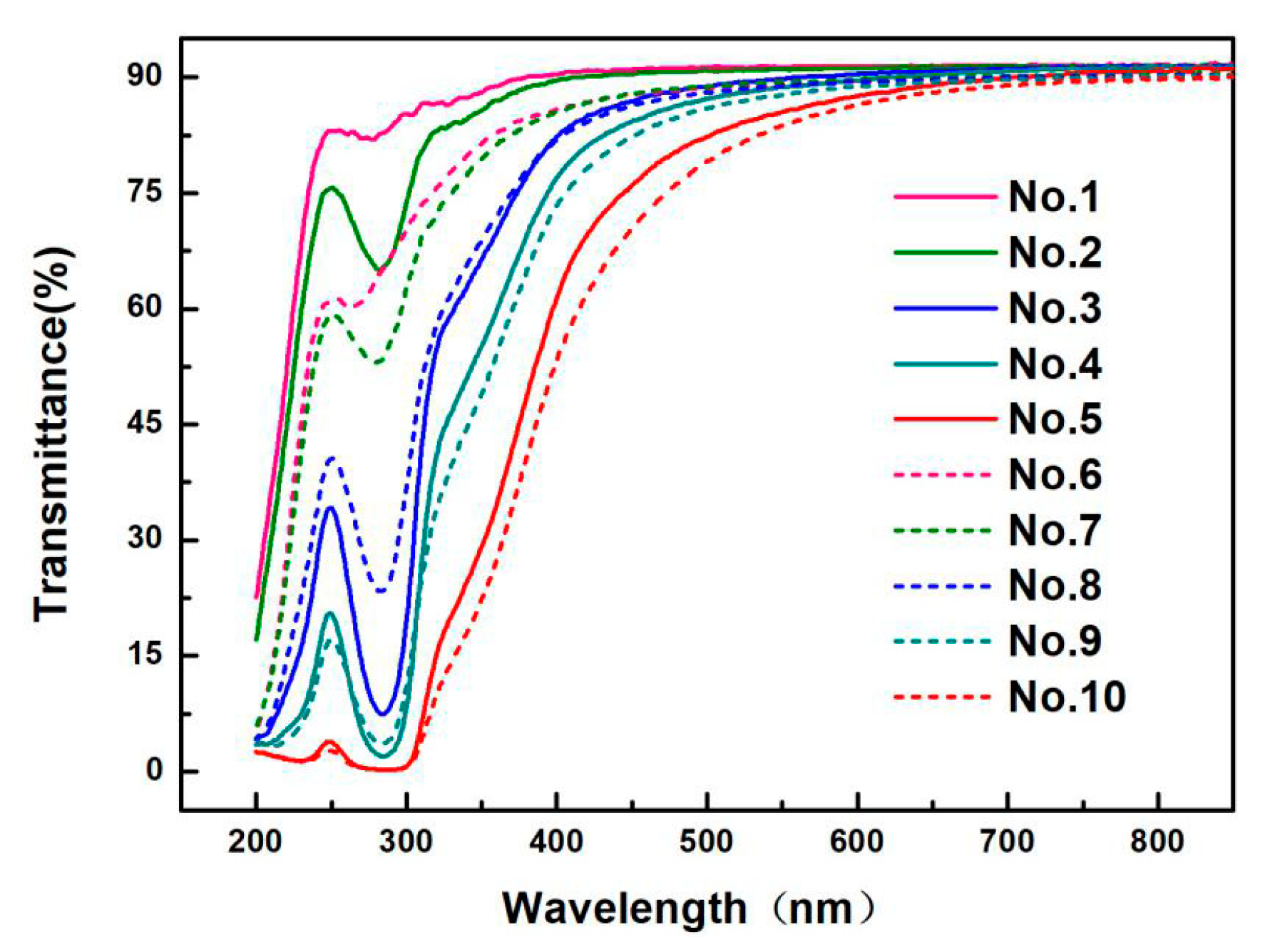
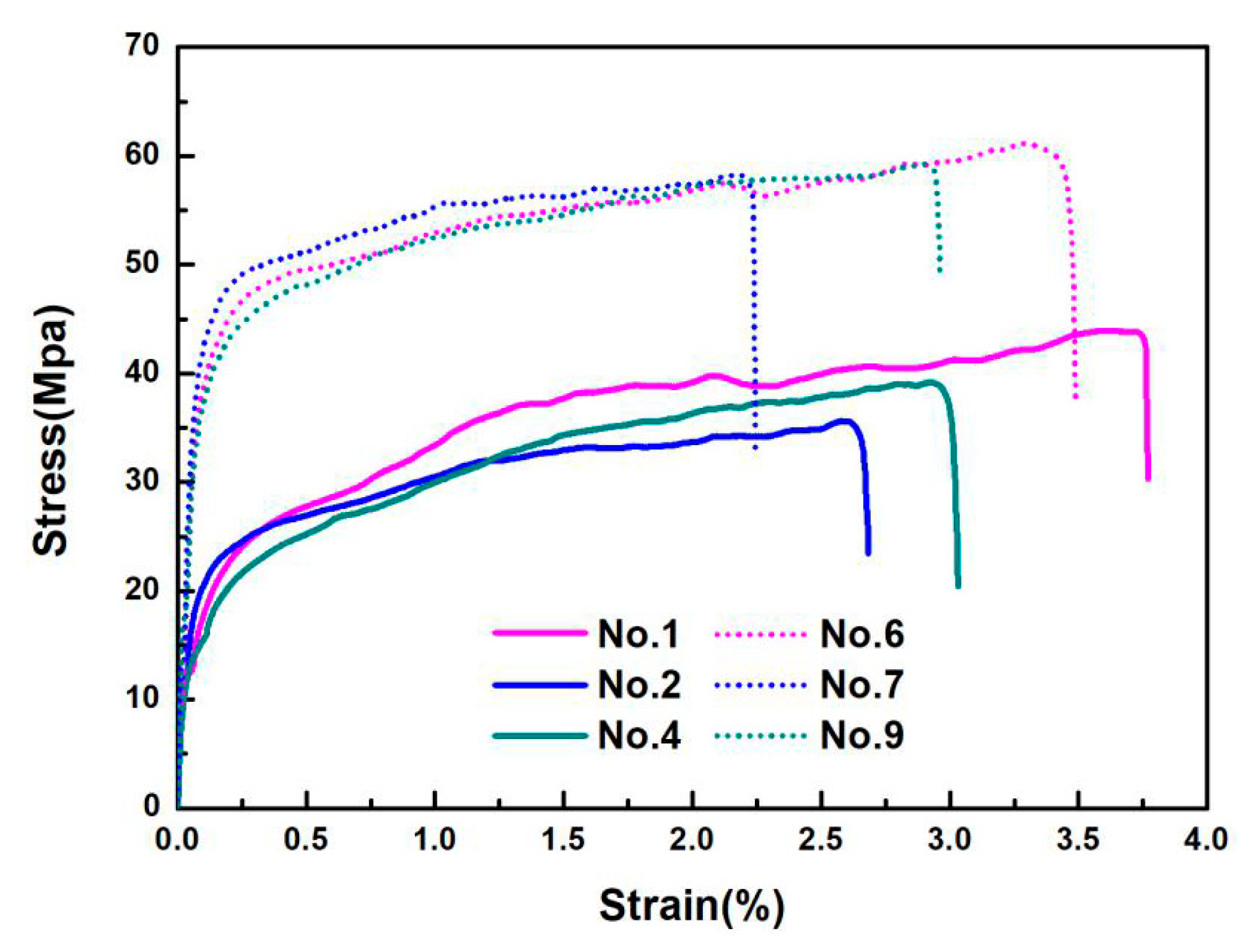
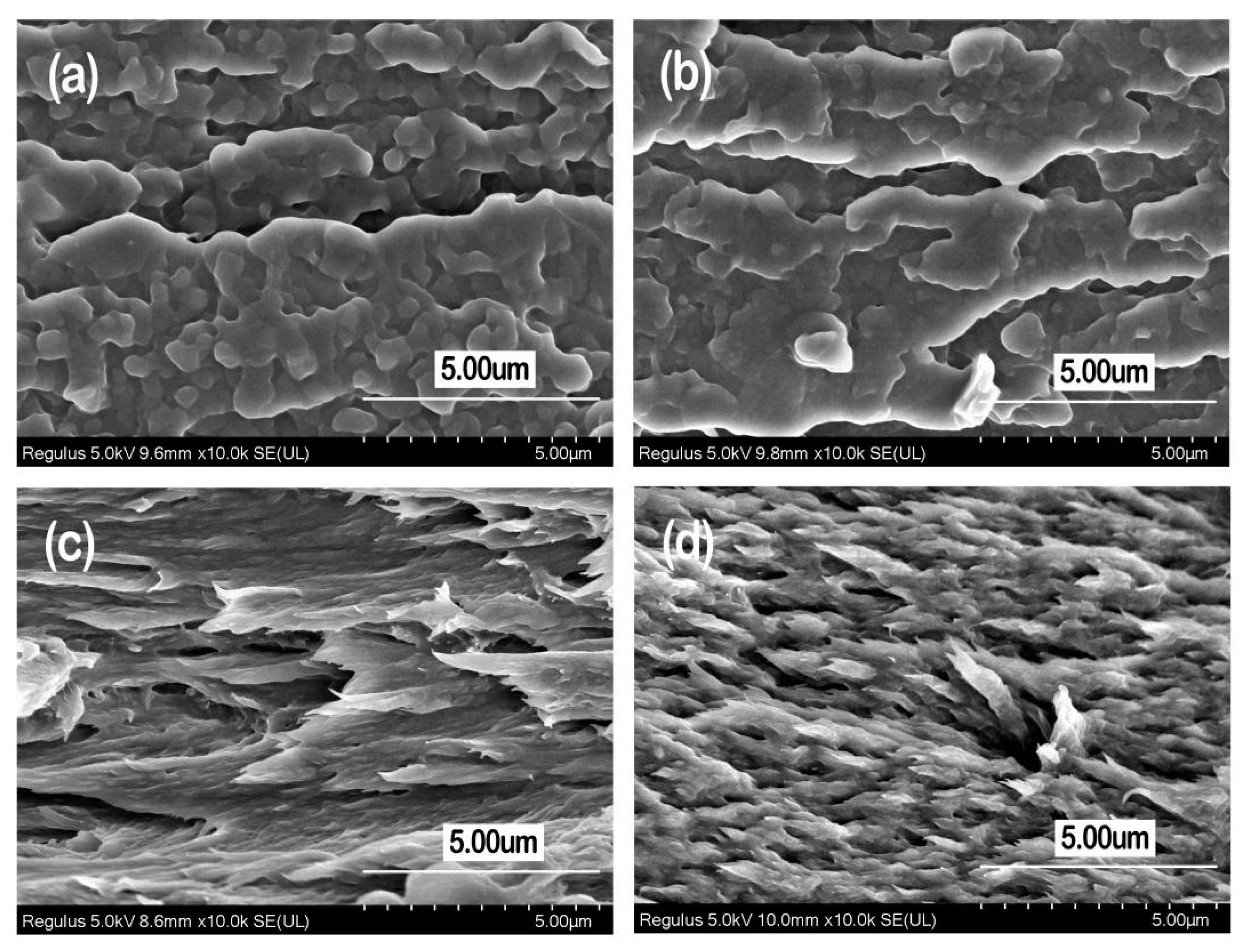


| Film No. | CQDs (0.1 wt.%)/mL | PVA (10%)/mL | CNF (1%)/mL |
|---|---|---|---|
| No. 1 | 0 | 10 | 0 |
| No. 2 | 0.2 | 10 | 0 |
| No. 3 | 1 | 10 | 0 |
| No. 4 | 2 | 10 | 0 |
| No. 5 | 4 | 10 | 0 |
| No. 6 | 0 | 10 | 10 |
| No. 7 | 0.2 | 10 | 10 |
| No. 8 | 1 | 10 | 10 |
| No. 9 | 2 | 10 | 10 |
| No. 10 | 4 | 10 | 10 |
| Wavenumber (cm−1) | Functional Groups | Vibrations |
|---|---|---|
| 3265, 3229 | –OH | stretching |
| 2935 | –CH2 | bending |
| 2908 | C–H | stretching |
| 1417 | C=O | stretching |
| 1087 | C–O | stretching |
| 830 | C–O–C | asymmetric aromatic ring skeleton |
| Film Number | Tensile Modulus (MPa) | Tensile Strength (MPa) | Elongation at Break (%) | Film Thickness (mm) |
|---|---|---|---|---|
| No. 1 | 580.76 (98.27 a) | 42.50 (2.42 a) | 345.02 (25.49 a) | 0.129 b |
| No. 2 | 824.84 (121.76 a) | 48.58 (6.68 a) | 302.83 (48.24 a) | 0.115 b |
| No. 4 | 881.28 (125.59 a) | 45.91 (3.42 a) | 287.69 (32.89 a) | 0.177 b |
| No. 6 | 1291.00 (245.55 a) | 51.68 (6.51 a) | 254.77 (54.01 a) | 0.137 b |
| No. 7 | 1185.25 (121.26 a) | 56.37 (4.64 a) | 264.39 (27.02 a) | 0.157 b |
| No. 9 | 1316.06 (164.72 a) | 59.71 (5.22 a) | 313.01 (10.43 a) | 0.163 b |
© 2019 by the authors. Licensee MDPI, Basel, Switzerland. This article is an open access article distributed under the terms and conditions of the Creative Commons Attribution (CC BY) license (http://creativecommons.org/licenses/by/4.0/).
Share and Cite
Xu, L.; Zhang, Y.; Pan, H.; Xu, N.; Mei, C.; Mao, H.; Zhang, W.; Cai, J.; Xu, C. Preparation and Performance of Radiata-Pine-Derived Polyvinyl Alcohol/Carbon Quantum Dots Fluorescent Films. Materials 2020, 13, 67. https://doi.org/10.3390/ma13010067
Xu L, Zhang Y, Pan H, Xu N, Mei C, Mao H, Zhang W, Cai J, Xu C. Preparation and Performance of Radiata-Pine-Derived Polyvinyl Alcohol/Carbon Quantum Dots Fluorescent Films. Materials. 2020; 13(1):67. https://doi.org/10.3390/ma13010067
Chicago/Turabian StyleXu, Li, Yushu Zhang, Haiqing Pan, Nan Xu, Changtong Mei, Haiyan Mao, Wenqing Zhang, Jiabin Cai, and Changyan Xu. 2020. "Preparation and Performance of Radiata-Pine-Derived Polyvinyl Alcohol/Carbon Quantum Dots Fluorescent Films" Materials 13, no. 1: 67. https://doi.org/10.3390/ma13010067





